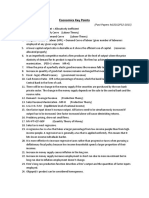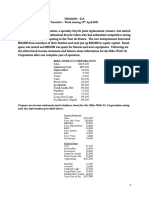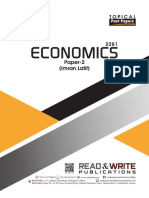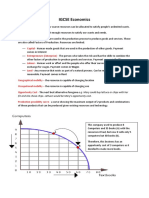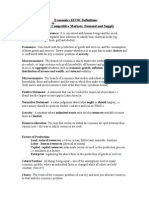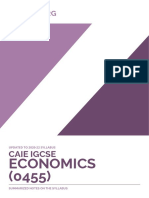A Level Economics Definitions by Wei Seng
A Level Economics Definitions by Wei Seng
Uploaded by
kamla sawmynadenCopyright:
Available Formats
A Level Economics Definitions by Wei Seng
A Level Economics Definitions by Wei Seng
Uploaded by
kamla sawmynadenCopyright
Available Formats
Share this document
Did you find this document useful?
Is this content inappropriate?
Copyright:
Available Formats
A Level Economics Definitions by Wei Seng
A Level Economics Definitions by Wei Seng
Uploaded by
kamla sawmynadenCopyright:
Available Formats
A-PDF Watermark DEMO: Purchase from www.A-PDF.
com to remove
Important Terms & the watermark
Definitions | H2 Economics
IMPORTANT TERMS & DEFINITIONS [ECONOMICS]
Microeconomics
1. Introduction to Economics
Scarcity Situation where limited resources available unable to satisfy unlimited
human wants
Opportunity Cost (OC) Cost of any activity measured in terms of next best alternative forgone
Production Possibility Curve Shows all different maximum attainable combinations of goods &
(PPC) services produced when all available resources are used efficiently at
given state of technology
Law of Increasing Opportunity As more of a good is produced, more of another good has to be
Cost sacrificed in production
Comparative Advantage When one can perform an activity at a lower opportunity cost than
anyone else
Law of Comparative Advantage Trade can benefit countries if they specialize in goods in which they
have a comparative advantage
2. Demand & Supply
Law of Demand Inverse relationship exists between price of good and quantity
demanded of good, ceteris paribus
Law of Supply Direct relationship exists between price of good and quantity supplied
of good, ceteris paribus
Price Elasticity of Demand (PED) Degree of responsiveness of quantity demanded of good to a change in
its own price, ceteris paribus
Income Elasticity of Demand Degree of responsiveness of demand to a change in income of
(YED) consumers, ceteris paribus
Cross Elasticity of Demand (XED) Degree of responsiveness of demand for one product to a change in
price of another, ceteris paribus
Price Elasticity of Supply (PES) Degree of responsiveness of quantity supplied of good to a change in its
own price, ceteris paribus
Consumer Surplus (CS) Excess of price buyers willing and able to pay for good over actual price
paid
Producer Surplus (PS) Excess of what producer willing and able to put up for sale for a good
over actual price paid
Deadweight Loss Loss in welfare not gained by anyone in society
Tax Incidence Division of tax between consumers & producers
Subsidies Fixed amount of money given to producers for each unit sold that
lowers cost of good
Price Floor (minimum price) Legally established minimum price above market equilibrium price
Price Ceiling (maximum price) Legally established maximum price below market equilibrium price
Black Market Market where sellers ignore government’s price restrictions & sell
illegally at whatever price equates illegal demand & supply
3. Cost Theory & Size of Firms
Fixed Factor Factor of production whose quantity cannot be changed in short run to
change output
Variable Factor Factor of production whose quantity can be changed within time period to
change output
Copyright © 2008-2010. Woon Wei Seng. 1
Distributed on Erpz.net
Important Terms & Definitions | H2 Economics
Short Run Production period in which there is / are fixed factor(s)
Long Run Production period in which there are no fixed factors
Law of Diminishing Marginal As more units of a variable factor are added to an unchanging fixed factor,
Returns (LDMR) the marginal product generated by adding the variable factor will
eventually decrease
Marginal Cost Additional cost from additional output
Economies of Scale Unit costs decrease as scale of production increases
Diseconomies of Scale Unit costs increase as scale of production increases
Minimum Efficient Scale Occurs at where LRAC curve stops falling / lowest point of LRAC curve
(MES)
Internal Expansion Expanding productive capacity to enjoy internal EOS
Horizontal Integration Merger of two firms at same stage of production
Vertical Integration Merger of two firms at different stages of production
Conglomerate Integration Combination of two firms of different industries with nothing in common
4. Perfect Competition & Monopoly
Perfect Competition Market of many buyers and sellers of a homogeneous good
Monopoly Market of only one seller of a product without substitutes (absence of
competition)
Price Taker A firm that takes the price from the market as given, without ability to
influence the price
Price Setter A firm that has the ability to influence the market price
Productive Efficiency Occurs when firm is able to produce an output at any point along LRAC curve
in long run or least cost at any given period
Allocative Efficiency Occurs at where output level when price of good equals marginal cost of
producing it
Natural Monopoly When it is cost efficient to have a single firm in the industry such that it has
lower AC (substantial EOS) over range of market demand
Predatory Pricing Selling below cost price to drive out competitors
Cartel Agreement among existing suppliers to keep out competitors
X-inefficiency Occurs when a firm becomes complacent and suffers from inefficiency due to
lack of competition
Price Discrimination Charging different prices for the same product or for different units of it
when such price differences is not because of cost differences
1st Degree Price Monopolist sells each unit to consumers at maximum price they are willing to
Discrimination pay
2nd Degree Price Monopolist sets uniform price per unit for specific quantity of good and
Discrimination lower price per unit for subsequent units
3rd Degree Price Monopolist charges different prices for the same commodity in different
Discrimination markets
5. Oligopoly & Monopolistic Competition
Oligopoly Market where few large firms have large market share
Monopolistic Competition Market where many small firms exist, each providing different products or
services
Price Rigidity Tendency for prevailing market prices to remain stable over a long time
Mutual Interdependence Each firm affects rival firms’ decisions and are also affected by rival firms’
decisions
Copyright © 2008-2010. Woon Wei Seng. 2
Distributed on Erpz.net
Important Terms & Definitions | H2 Economics
Product Innovation Differentiation of product in consumer’s viewpoint through improvements to
product
Process Innovation Reducing AC without sacrificing profits through streamlining processes
Brand Proliferation Firms produce many brands to saturate market, leaving no gaps for rivals
Market Segmentation Segmenting market into sub-markets / market niches with different needs
catered through product innovation
Kinked Demand Curve Theory Explains price rigidity; TR falls when prices rise / fall as rivals will match price
decreases but not price increases
Price Wars Used to eliminate new competitors, when a firm lowers its price, other firms
start lowering prices and keep undercutting competitors price
Collusive Oligopoly When there are tacit / explicit agreements among firms on operations
Cartel Theory Formal arrangement by sellers to fix prices through manipulating supply to
the market
Price Leadership Theory Oligopolists agree to set same price as price leader in industry, allowing price
adjustments without price wars
Dominant Firm Price Others in industry follow largest producer in industry in price changes
Leadership
Barometric Firm Price Others in industry follow price changes of producer most sensitive to market
Leadership conditions
Contestable Market Theory In a market of free entry & exit, number of firms in industry unimportant
since firms always behave as if competition is very strong (no matter number
of firms)
Differentiated Product Product that is slightly different from and yet close substitute to product of
other firms in industry
Product Development Production of good with potentially high demand and different from
products of rival firms or provision / improvement of service to better / differ
from rivals
Excess Capacity Theorem Firms inefficient in using society’s & own resources, thus not producing at
socially ideal output
6. Alternative Theories of the Firm
Profit Satisficing Where managers of firm make enough profit to satisfy shareholder demands
instead of profit maximizing
Managerial Theories Managers, with discretionary power and freedom to run the firm, maximize
their own utility instead of profit
Revenue Maximization Firms aim to maximize sales revenue instead of profits
Growth Maximization Firms aim to maximize growth instead of profits
Organizational Slack Tendency of firms in non-competitive markets to produce at higher than AC
(X-Inefficiency)
Nationalization Industry put under ownership and control of the state
Privatization Returning state-owned corporations to private sectors, involving transfer of
assets from public to private sector
7. Market Failure & Government Intervention
Social Efficiency / Pareto Achieved when no one can be made better off without someone being made
Optimality worse off
External Benefits Benefits from production / consumption experienced by people other than
the producer / consumer (third parties)
External Costs Costs from production / consumption experienced by people other than the
producer / consumer (third parties)
Copyright © 2008-2010. Woon Wei Seng. 3
Distributed on Erpz.net
Important Terms & Definitions | H2 Economics
Private Marginal Benefit Value the consumer places on last unit of good produced, equal to price and
(PMB) of good thus represented by demand
Private Marginal Cost (PMC) OC of resources used up in making additional unit of good, represented by
of good supply
Social Marginal Benefit Sum of PMB and External Benefit to represent marginal benefit on society
(SMB)
Social Marginal Cost (SMC) Sum of SMC and External Cost to represent marginal cost on society
Underproduction When in the production of the good, SMB > SMC (production can be
increased to socially optimum output)
Overproduction When in the production of the good, SMC > SMB (production can be
decreased to socially optimum output)
Market Failure Free markets, operating without government intervention, fail to deliver
socially efficient allocation of resources to produce good & services
Public Good Good / service with characteristic of non-excludability and non-rivalry
Positive Externalities Benefits from production or consumption experienced by society but not by
producers or consumers themselves
Negative Externalities Costs from production or consumption experienced by society but not by
producers or consumers themselves
Merit Goods Goods or services deemed socially desirable by government and seen as
underproduced and thus underconsumed
Demerit Goods Goods or services deemed socially undesirable by government and seen as
overproduced and overconsumed
Geographical Immobility Where barriers to people moving from one region to another thus
disallowing resources to respond to incentives to produce more goods &
services demanded
Occupational Immobility Mismatch of skills as labour is not transferable across industries as
demanded, leading to waste of resources
Government Failure Allocative efficiency is reduced following government intervention aimed to
correct market failure
Copyright © 2008-2010. Woon Wei Seng. 4
Distributed on Erpz.net
Important Terms & Definitions | H2 Economics
Macroeconomics
1. National Income Accounting
National income Total value of an economy’s final output of goods & services in a year
(NNP at Factor cost)
Households Basic consumers of finished products & owners of factors of production
Firms Basic producers of finished products & buyers of factor services
Gross Domestic Product (GDP) Total market value of all final goods & services newly produced within
country
Gross National Product (GNP) Total market value of all final goods & services newly produced by
productive factors of country’s citizens (GDP + NPIA)
GDP/GNP per capita GDP / GNP divided by population
Net Property Income from Difference between property income from abroad & factor income paid
Abroad (NPIA) abroad
Market price Value of output at shop level / price purchasers pay for goods & services
sold
Factor cost What factors of production received for goods & services produced
GDP at Factor cost (GDP at market price – Indirect tax + Subsidies)
Capital depreciation Loss in value of physical assets due to wear & tear
Net National Product (NNP) (GNP – Depreciation)
Real GNP Level of output in terms of physical quantities without price changes
(Nominal GNP⁄GNP deflator)
Nominal GNP Value of output measured at current prices
Purchasing Power Parity (PPP) How much goods & services can be bought by a unit of currency at
home compared with purchasing power of other countries’ currency
2. National Income Determination
Keynesian Theory Fundamental problem causing depression is insufficient demand for
goods & services, so fiscal policy can revive the economy
Desired Aggregate Expenditure Total planned expenditure on goods & services in an economy (C + I + G
(AE) + X – M for 4-sector economy)
Equilibrium NI Level of NI once reached will be maintained unless the economy is
disturbed
Leakage / withdrawal Siphoning off of expenditure from income flow between firms &
households
Injection Additional expenditure into domestic income flow
Autonomous consumption Minimal consumption households will still spend when income is zero
Induced consumption Amount of consumption changing when income changes
Average Propensity to Consume Proportion of total income consumed (C⁄Y)
(APC)
Average Propensity to Save Proportion of total income saved (S⁄Y)
(APS)
Marginal Propensity to Change in consumption as income changes (∆C⁄∆Y or 1 – MPS or 1 -
Consume (MPC) MPW)
Marginal Propensity to Save Change in saving as income changes (∆S⁄∆Y)
(MPS)
Marginal Propensity to Change in withdrawals as income changes (MPS + MPM + MPT)
Withdrawal (MPW)
Investment Expenditure on production of capital goods and net additions to goods
Copyright © 2008-2010. Woon Wei Seng. 5
Distributed on Erpz.net
Important Terms & Definitions | H2 Economics
stocks
Marginal Efficiency of Negative relationship between interest rates & level of investment
Investment (MEI)
Government expenditure Current spending & capital spending by the government on provision of
goods & services
Full-employment level of NI Level where there is no deficiency in demand / full employment of
production factors / production on PPC
Deflationary gap Shortfall of AE below NI at full-employment level, causing demand-
deficient unemployment
Inflationary gap Excess of AE above NI at full-employment level, causing demand-pull
inflation
Multiplier (k) Number of times income changes as injection changes (∆I⁄∆AE)
Aggregate Demand (AD) Inverse relationship between price level & real equilibrium output
where planned spending = actual output
Aggregate Supply (AS) Amount of goods & services all firms in economy willing to supply at
different price levels
3. Unemployment & Inflation
Unemployment Number of people of working age without work, but willing & able to
take up employment
Overheating Economy growing too quickly that high inflation occurs
Labour force All within working age (15<) who are able & willing to work and are
either employed or seeking employment
Frictional unemployment Unemployment occurring as workers change jobs / look for jobs after
completing studies
Seasonal unemployment Unemployment varying with season / weather
Structural unemployment Unemployment resultant from geographical immobility of labour &
occupational immobility of labour
Geographical immobility of Labour unwilling to move to another region where prospects are better
labour
Occupational immobility of Labour that do not have the necessary skills required by the employer
labour
Technological unemployment Unemployment from labour made redundant as a result of increased
automation
Cyclical / Demand-deficient / Unemployment as workers are retrenched in a recession / depression
Keynesian unemployment (as part of the business cycle)
Full employment Occurs in economy when there is no cyclical unemployment
Inflation Sustained increase in general price level of a country, as prices rise and
value of money falls
Consumer Price Index (CPI) Measures average price level of basket of goods & services consumed by
typical household
Hyperinflation Prices rise so fast that money ceases to be a medium of exchange &
normal economic activity breaks down
Demand-pull inflation Prices rise as supply cannot expand to meet demand
Cost-push inflation Prices rise as production costs rise
Wage-push inflation Inflation caused by wages rising faster than productivity gains
Import-price-push inflation Inflation caused by inflation in other countries where goods are
imported from or when local currency depreciates
Profit-push inflation Inflation caused by firms use market power to raise prices above what is
required to offset increases in cost of production to increase profits
Copyright © 2008-2010. Woon Wei Seng. 6
Distributed on Erpz.net
Important Terms & Definitions | H2 Economics
Tax-push inflation Inflation caused by increases in indirect taxes adding to cost of living
Wage-price spiral Prices keep rising in vicious cycle as wages rise to offset higher costs of
living & firms increase prices to cover appreciating costs of production
Anticipated inflation Where rise in general price level is expected
Shoe leather costs Costs incurred by people & firms trying to minimize holdings of cash
4. Public Finance
Current / Ordinary expenditure Expenditure incurred in day-to-day routine work and recurrent year
after year
Development / Capital Spending on public investment
expenditure
Progressive tax As income increases, proportion of tax on one's income increases
Regressive tax As income increases, proportion of tax on one's income decreases
Proportional tax As income increases, proportion of tax on one's income remains the
same
Income tax Tax on 'earned' & 'unearned' income, taxed progressively
Corporation tax Tax on firm's profits, usually taxed proportionally
Capital gains tax Tax on capital gains and capital appreciation of assets (land, shares etc)
Property tax Tax on annual rental value of land & buildings, usually proportional tax
Stamp duty Tax on legal & commercial down payments
Ad valorem tax Tax on fixed proportion of value of good or service (%)
Specific tax Tax on fixed amount per unit of good or service ($)
Value-added tax (VAT) Multi-stage tax levied on net value added at each stage of production
Excise duty Tax on manufacturer of goods so as to curtail domestic consumption
Customs duties / Tariffs Tax on goods imported from outside the country, to raise revenue or for
protectionist reasons
5. Fiscal Policy
Government budget Estimate of government revenue & expenditure for coming year
Balanced budget Estimated revenue = Estimated expenditure
Deficit budget Estimated revenue < Estimated expenditure
Surplus budget Estimated revenue > Estimated expenditure
Deficit financing Financing extra spending by government through other methods (e.g.
borrowing)
Fiscal policy Government policy where government expenditure is increased & taxes
are reduced to stimulate economy
Automatic fiscal stabilizers Built-in features of economy operating automatically to smooth out
fluctuations in disposable income over business cycles, without
government intervention
Disposable income Income households have available to spend after paying income taxes &
receiving transfer payments (e.g. unemployment benefits)
Crowding-out effect Government cuts taxes or expands borrowing to finance increased
expenditure, crowding out private investment due to higher interest
rates
6. Interest Rate Determination & Monetary Policy
Money supply Quantity / Stock of money held by households & firms in economy
Copyright © 2008-2010. Woon Wei Seng. 7
Distributed on Erpz.net
Important Terms & Definitions | H2 Economics
Demand deposits Money deposits in checking accounts (for checks)
Nominal money Amount of money in dollars & cents
Real money Amount of goods & services one can purchase with the money
Money substitutes Items serving as temporary medium of exchange but not stores of value
Fiat money Notes & coins determined as legal tender but not backed by gold,
circulated by faith alone
Interest rates (Rate charged) Cost of borrowing & reward for lending
Nominal interest rate Interest rate charged by lender
Real interest rate Nominal interest rate minus inflation rate
Demand for money Desire to hold money rather than spend it or for financial investment
Liquidity preference Desire to hold non-interest bearing cash balances as part of wealth
portfolio instead of interest-bearing bonds
Transactions motive Cash balances to meet planned expenses
Precautionary motive Cash balances to meet unforeseen expenses
Speculative motive / Idle Cash balances to purchase assets & bonds to make capital gains
balances
Total demand for money Active balances (Transactions motive & precautionary motive) + Idle
balances
Loanable funds Funds available for lending
Central bank Institution supervising monetary system, implementing monetary policy
& ensuring banks & financial institutions operate efficiently
Monetary policy Deliberate attempt by Central Bank to regulate money supply or
manipulate interest rates
Irrational exuberance Consumers continue to spend regardless of high interest rates because
of high consumer confidence
Velocity of money Rate at which money supply turns over each year
7. Economic Growth
Economic growth Annual percentage increase in real value of goods and services
produced by economy
Actual economic growth Annual percentage increase in national output
Potential economic growth Speed at which economy could grow / Percentage annual increase in
economy's capacity to produce
Human capital Accumulated skill & knowledge of workers
8. Supply-side Policy
Supply-side policy Focusing on adjusting AS such that the AS curve expands outwards
Prices & income policy Direct or indirect intervention by government on wage-price setting to
influence inflation rate
Earnings Wages + Overtime payments + Bonuses
9. International Trade
Trade Exchange of goods & services between two parties
International trade Exchange of goods & services across national borders
Factor price equalization Prices of factor inputs brought closer to each other
Absolute advantage Where a country can produce more of a good using the same amount of
resources
Copyright © 2008-2010. Woon Wei Seng. 8
Distributed on Erpz.net
Important Terms & Definitions | H2 Economics
Comparative advantage Where a country can produce a good at a lower opportunity cost than
another country
Law of comparative advantage Trade can benefit all countries if they specialize in goods in which they
have a comparative advantage
Terms of trade (TOT) Rate at which one good can be exchanged for another
Terms of trade index Comparison of export price index with import price index (Export Price
Index/Import Price Index X 100%)
Balance of trade (BOT) Difference between value of commodity exports & imports (Export
revenue-Import spending)
Free trade Exchange of goods & services between countries without any artificial
restrictions
Protectionism Policy of sheltering domestic industries from foreign competition
through tariff & non-tariff barriers
Infant industry Industry with potential comparative advantage but too young /
undeveloped to realize potential
Dumping Selling of goods in foreign market below cost price / price sold in home
market
Import quota Legal limit on quantity of imports over given time period
Subsidy Indirect protection of domestic producers so they become more
competitive against more efficient foreign producers
Voluntary restraint agreement Agreement to reduce trade volume in specific good
(VRA)
Exchange control Government's buying & selling of foreign exchange to regulate imports
& exports to ensure healthy BOP and prevent undue fluctuations in
country's foreign exchange value
Embargo Total ban on certain imports
Economic integration Neighboring countries integrate as an economic unit to take advantage
of extended market & allow better allocation of resources
Free trade area (FTA) Agreement where member countries agree to remove tariff & non-tariff
barriers among themselves but retain restrictions against non-member
countries
Trade deflection Imports enter FTA via country with lowest external tariff
Customs union (CU) Agreement where member countries remove all trade barriers among
themselves & adopt common external tariff for non-member countries
Common market Member countries operate as a single market, lifting all restrictions on
trade in services, capital & labour movements and adopting laws &
regulations on trade, production & employment
Trade diversion Trade diverted from more efficient non-member producer to less-
efficient but tariff-free member nation
Balance of payments (BOP) Summary statement of money value of economic transactions between
country residents & rest of world
Credit item (+) International transaction earning foreign currency, providing demand of
domestic currency
Debit item (-) International transaction requiring foreign currency to make payments,
providing supply of domestic currency
Current account Flow of goods & services + incomes & net transfer of money flowing into
& out of country
Trade in goods account Import & export of tangible goods
Trade in services account Import & export of services (invisibles)
Income flows Investment income in forms of rent, interest, profits & dividends (net
property income from abroad)
Copyright © 2008-2010. Woon Wei Seng. 9
Distributed on Erpz.net
Important Terms & Definitions | H2 Economics
Current transfers Unilateral flows such as government contributions & receipts from
international organizations & remittances
Capital account Records debt forgiveness, migrant transfers & acquisition & disposal of
non-financial assets such as patents & copyrights
Financial account Records purchase & sales of assets in terms of direct investment,
portfolio investment & monetary flows
Direct investment Purchase & sale of real assets (capital goods)
Portfolio investment Purchase & sale of shares & bonds (long-term investment)
Monetary flows Bank deposits, loans & debts (short-term investment)
Balancing item Statistical adjustment to record errors & omissions in calculations
Official Reserves Account (ORA) Accommodates surpluses or deficits in overall balance
BOP equilibrium Trade & capital flows into & out of country equal over number of years
BOP disequilibrium Persistent tendency for outflows to be greater or less than
corresponding inflows
Expenditure-reducing policies Contractionary demand-side policies to reduce imports and hence AD &
NI of country
Expenditure-switching policies Policy that raises import prices relative to domestic-produced goods
Marshall-Lerner (ML) condition Sum of PEDX & PEDM > 1 for devaluation of currency to be successful in
correcting adverse BOP
J-curve effect Where current account worsens in short-run after currency devaluation
before improving
Foreign exchange (Forex) Trading of one country's currency for another foreign currency
Exchange rate Rate at which one currency is exchanged for another
Nominal exchange rate Exchange rate based on nominal value of currency before adjustment to
price changes
Bilateral exchange rate Exchange rate between two currencies
Trade-weighted / Effective Value of currency against basket of other currencies of major trading
exchange rate partners
Derived demand for currency Currency demand stems from foreigners' demand for our goods,
services & financial assets
Depreciation One currency weakens relative to another, when demand for it falls or
supply for it rises
Appreciation One currency strengthens relative to another, when demand for it rises
or supply for it falls
Purchasing power parity (PPP) Equilibrium rate of exchange between two currencies determined by
theory relative domestic purchasing power; exchange rates between two
currencies in equilibrium when equivalent domestic purchasing power
Fixed exchange rate Government of country fixes & guarantees official price of currency in
terms of other foreign currencies
Devaluation Government declares lowering of fixed exchange rate
Revaluation Government declares raising of fixed exchange rate
Freely-floating / Flexible Exchange rate determined freely by market forces of demand & supply
exchange rate in forex market
Managed float exchange rate Government lets market forces determine exchange rate but will
interfere to change it if beyond certain band
Copyright © 2008-2010. Woon Wei Seng. 10
Distributed on Erpz.net
You might also like
- Economics Edexcel As Unit 1 Workbook AnswersDocument73 pagesEconomics Edexcel As Unit 1 Workbook AnswersSam catlin100% (3)
- Macro Examples For Everything by EconplusDalDocument6 pagesMacro Examples For Everything by EconplusDalMukmin ShukriNo ratings yet
- Igcse Economics Notes 0455Document74 pagesIgcse Economics Notes 0455fifth193100% (1)
- A Level Economics NotesDocument41 pagesA Level Economics Notestasleemfca100% (6)
- Chapter 32 - Efficiency and Market FailureDocument24 pagesChapter 32 - Efficiency and Market FailurePhuong Dao100% (1)
- Revision Checklist For AS Economics 9708 FINAL PDFDocument10 pagesRevision Checklist For AS Economics 9708 FINAL PDFAkshaya Bhattarai100% (2)
- Economics 9708 A Level P3 NotesDocument12 pagesEconomics 9708 A Level P3 NotesFatima Rehan88% (8)
- FINAN204-21A - Tutorial 6 Week 7Document10 pagesFINAN204-21A - Tutorial 6 Week 7Danae YangNo ratings yet
- Caie Igcse Business Studies 0450 Definitions v1Document8 pagesCaie Igcse Business Studies 0450 Definitions v1Ashley Kyaw100% (1)
- Caie A2 Level Business 9609 Model Answers v1Document12 pagesCaie A2 Level Business 9609 Model Answers v1Jude ChamindaNo ratings yet
- IG Economics Paper 1 Exemplar Responses With CommentariesDocument37 pagesIG Economics Paper 1 Exemplar Responses With CommentariesShibraj DebNo ratings yet
- Economics QS Workbook Answers For IBEXTRASDocument74 pagesEconomics QS Workbook Answers For IBEXTRASSkruzdelyte Miela100% (1)
- A level Economics Revision: Cheeky Revision ShortcutsFrom EverandA level Economics Revision: Cheeky Revision ShortcutsRating: 3 out of 5 stars3/5 (1)
- As Eco Guess Paper-2Document2 pagesAs Eco Guess Paper-2QamarBalochNo ratings yet
- Article 142 Editorial BoardDocument18 pagesArticle 142 Editorial BoardKamranKhanNo ratings yet
- Topical PapersDocument32 pagesTopical PapersKeya NandiNo ratings yet
- A Level Economics - Evaluation TechniquesDocument5 pagesA Level Economics - Evaluation TechniquesMyref100% (1)
- The Investment Detective Case StudyDocument3 pagesThe Investment Detective Case StudyItsCj100% (1)
- Caie A2 Economics 9708 Definitions v2Document6 pagesCaie A2 Economics 9708 Definitions v2ARMANI ROYNo ratings yet
- IBDP Economic HL Chapter 5 NotesDocument9 pagesIBDP Economic HL Chapter 5 NotesAditya RathiNo ratings yet
- Eco As A Mind MapsDocument11 pagesEco As A Mind Mapsapi-235416878No ratings yet
- A Level Economics ProtectionismDocument8 pagesA Level Economics Protectionismchinsw1996No ratings yet
- 6.1 International Trade and Specialization: Igcse /O Level EconomicsDocument10 pages6.1 International Trade and Specialization: Igcse /O Level EconomicsAvely AntoniusNo ratings yet
- Caie A2 Level Economics 9708 Theory v1Document23 pagesCaie A2 Level Economics 9708 Theory v1ammarahmed8855No ratings yet
- Economics Paper 1 Tips - Economics and Business & Management - IB SurvivalDocument7 pagesEconomics Paper 1 Tips - Economics and Business & Management - IB SurvivalSandy SaddlerNo ratings yet
- Caie A2 Business 9609 Theory v1Document41 pagesCaie A2 Business 9609 Theory v1Tapiwa RusikeNo ratings yet
- CIE IGCSE Unit 3.3 - Workers - Occupations, Earnings and The Labour Market - Miss PatelDocument19 pagesCIE IGCSE Unit 3.3 - Workers - Occupations, Earnings and The Labour Market - Miss PatelJingyao HanNo ratings yet
- CIE IGCSE Unit 3.2 - Households - Spending, Borrowing and Saving - Miss PatelDocument32 pagesCIE IGCSE Unit 3.2 - Households - Spending, Borrowing and Saving - Miss PatelJingyao HanNo ratings yet
- Various A-Level Economics NotesDocument7 pagesVarious A-Level Economics NotesYasheelNo ratings yet
- 4.2 Organization of Production: Igcse /O Level EconomicsDocument15 pages4.2 Organization of Production: Igcse /O Level EconomicszainNo ratings yet
- Edexcel IGCSE Economics Blue Section SummaryDocument4 pagesEdexcel IGCSE Economics Blue Section SummaryAnnikaZimmermannNo ratings yet
- Ib Economics Study Guide MacroDocument43 pagesIb Economics Study Guide Macroapi-196719233100% (1)
- Igcse Economics Macro DiagramsDocument14 pagesIgcse Economics Macro DiagramsVÕ PHAN100% (1)
- Complete Macroeconomics Diagrams PDFDocument9 pagesComplete Macroeconomics Diagrams PDFMayfair NgNo ratings yet
- Econ Notes A LevelDocument37 pagesEcon Notes A Levelannaparker969No ratings yet
- A'Level Ecos NotesDocument342 pagesA'Level Ecos NotesBeckham T MaromoNo ratings yet
- 2.1 Economic Systems: Igcse /O Level EconomicsDocument13 pages2.1 Economic Systems: Igcse /O Level EconomicsJoe Amirtham0% (1)
- Business Studies IgcseDocument115 pagesBusiness Studies IgcsexNo ratings yet
- Caie Igcse Economics 0455 Definitions v1Document8 pagesCaie Igcse Economics 0455 Definitions v1Emma WangNo ratings yet
- IGCSE Economics Notes PDFDocument44 pagesIGCSE Economics Notes PDFWayne Wy40% (5)
- IGCSE 1.5 Business Objectives and Stakeholder ObjectivesDocument30 pagesIGCSE 1.5 Business Objectives and Stakeholder Objectivesayla.kowNo ratings yet
- Chapter 13 (Marketing Mix - Price) - 11.19.35Document21 pagesChapter 13 (Marketing Mix - Price) - 11.19.35Kelvin LauNo ratings yet
- Definitions For IB EconomicsDocument26 pagesDefinitions For IB EconomicsMohamed Mohideen75% (4)
- Ten Ways To Improve Your Evaluation Skills and Marks For A2 EconomicsDocument9 pagesTen Ways To Improve Your Evaluation Skills and Marks For A2 EconomicsJim Riley86% (7)
- Guidelines For Writing Paper 1Document31 pagesGuidelines For Writing Paper 1tyrramNo ratings yet
- Caie Igcse Economics 0455 Theory v1Document16 pagesCaie Igcse Economics 0455 Theory v1Mehri MustafayevaNo ratings yet
- Microeconomics: (S A M (P 1) )Document3 pagesMicroeconomics: (S A M (P 1) )Niaz MahmudNo ratings yet
- IB Economics Teacher Resource 3ed Paper 1 Markscheme 2Document28 pagesIB Economics Teacher Resource 3ed Paper 1 Markscheme 2kyamylamNo ratings yet
- 6.1 Price Inflation: Igcse /O Level EconomicsDocument11 pages6.1 Price Inflation: Igcse /O Level EconomicsAditya Ghosh100% (1)
- 7.2 Population: Igcse /O Level EconomicsDocument13 pages7.2 Population: Igcse /O Level EconomicsAditya GhoshNo ratings yet
- Economics Cheat Sheet - Ellie Tragakes 2Document108 pagesEconomics Cheat Sheet - Ellie Tragakes 2Ishaan Tandon67% (3)
- A Level Economics Synoptic Revision Mats Vol1 SampleDocument6 pagesA Level Economics Synoptic Revision Mats Vol1 SampleanusuyaNo ratings yet
- Definitions - Business Studies Unit 1Document3 pagesDefinitions - Business Studies Unit 1farazdrums8748100% (1)
- AS Level Economics Paper-2 (Qamar Baloch)Document2 pagesAS Level Economics Paper-2 (Qamar Baloch)Sarmad ShafiqueNo ratings yet
- IB Economics Notes - Macroeconomic Goals Low Unemployment (Part 1)Document11 pagesIB Economics Notes - Macroeconomic Goals Low Unemployment (Part 1)Pablo Torrecilla100% (2)
- Exam Practice Questions: 1.11 Price Controls: IB EconomicsDocument3 pagesExam Practice Questions: 1.11 Price Controls: IB EconomicsSOURAV MONDAL100% (1)
- IB Macro Study GuideDocument19 pagesIB Macro Study GuidePaola Fernanda Montenegro100% (5)
- Business Studies Exam Style QuestionsDocument6 pagesBusiness Studies Exam Style QuestionsBryan MendozaNo ratings yet
- IB Economics Teacher Resource 3ed Paper 2Document7 pagesIB Economics Teacher Resource 3ed Paper 2kyamylamNo ratings yet
- Caie As Economics 9708 Model Answers v1Document11 pagesCaie As Economics 9708 Model Answers v1Uzair siddiqui100% (1)
- I T & D (E) : Mportant Erms Efinitions ConomicsDocument10 pagesI T & D (E) : Mportant Erms Efinitions ConomicskulsumNo ratings yet
- RenewalPremium 24138798Document1 pageRenewalPremium 24138798vbbhagat1988No ratings yet
- Quant Common Application FormDocument6 pagesQuant Common Application FormkunaldaseflNo ratings yet
- Discover StatementDocument5 pagesDiscover StatementbaronwrkNo ratings yet
- Chai Man Micro ProjectDocument22 pagesChai Man Micro Projectgholapsandesh44No ratings yet
- Law of Insurance Basic Type Questions and AnswersDocument5 pagesLaw of Insurance Basic Type Questions and AnswersTobias WilsonNo ratings yet
- Convertibility of Rupee in IndiaDocument8 pagesConvertibility of Rupee in IndiaSimran SimieNo ratings yet
- Course Outline 3320 Latest (No SG) - October2023Document23 pagesCourse Outline 3320 Latest (No SG) - October2023Nabihah YahyaNo ratings yet
- SQP Accountancy 11Document12 pagesSQP Accountancy 11mamta.bdvrrmaNo ratings yet
- Introduction and BackgroundDocument3 pagesIntroduction and BackgroundMystica BayaniNo ratings yet
- ACP311 Special Transaction LecturesDocument33 pagesACP311 Special Transaction LecturesJohn Stephen PendonNo ratings yet
- Final ResultDocument4 pagesFinal ResultvaliaNo ratings yet
- African Construction Cost HandbookDocument369 pagesAfrican Construction Cost HandbookTran Ngo Trung Hau100% (1)
- MT - 03 (C Unit) With AnswerDocument6 pagesMT - 03 (C Unit) With AnswerNasif FuadNo ratings yet
- Chapter 3Document100 pagesChapter 3HayamnotNo ratings yet
- An Assignment On "Case Study of Merger of Bank of Baroda With Vijaya Bank and Dena Bank"Document15 pagesAn Assignment On "Case Study of Merger of Bank of Baroda With Vijaya Bank and Dena Bank"Shubham DeshmukhNo ratings yet
- Case DigestDocument13 pagesCase Digestmaryjanefernandez311No ratings yet
- Strategic Management Chapter 5 PPT Strategic Management Chapter 5Document19 pagesStrategic Management Chapter 5 PPT Strategic Management Chapter 5Marjon DimafilisNo ratings yet
- bài tập logisticDocument7 pagesbài tập logisticNguyễn T. HàNo ratings yet
- Secretary CertificatemetrobankDocument3 pagesSecretary CertificatemetrobankMhayo Moreno - Calimutan100% (1)
- Final Internship ReportDocument43 pagesFinal Internship ReportDeepak GuptaNo ratings yet
- Document 1730671429865Document1 pageDocument 1730671429865sewakhelplineNo ratings yet
- Tugas Manajemen Keuangan (Working Capital)Document7 pagesTugas Manajemen Keuangan (Working Capital)anaNo ratings yet
- AKA Company ProfileDocument25 pagesAKA Company ProfileFahim ChapraNo ratings yet
- Fra LVMH InditexDocument7 pagesFra LVMH InditexValentina EcheverriNo ratings yet
- DB6 - Worksheet & FS Prep For Merchandising BusinessDocument4 pagesDB6 - Worksheet & FS Prep For Merchandising BusinessArrianeNo ratings yet
- Aparna Zicon Price ListDocument1 pageAparna Zicon Price ListBramarish KadakuntlaNo ratings yet
- 2022 Icc Use of Sanctions 03 003Document7 pages2022 Icc Use of Sanctions 03 003Muthu SelvanNo ratings yet
- Apollo Tyres (APTY IN, Buy) - 1QFY20 Result - NomuraDocument7 pagesApollo Tyres (APTY IN, Buy) - 1QFY20 Result - NomuradarshanmaldeNo ratings yet







